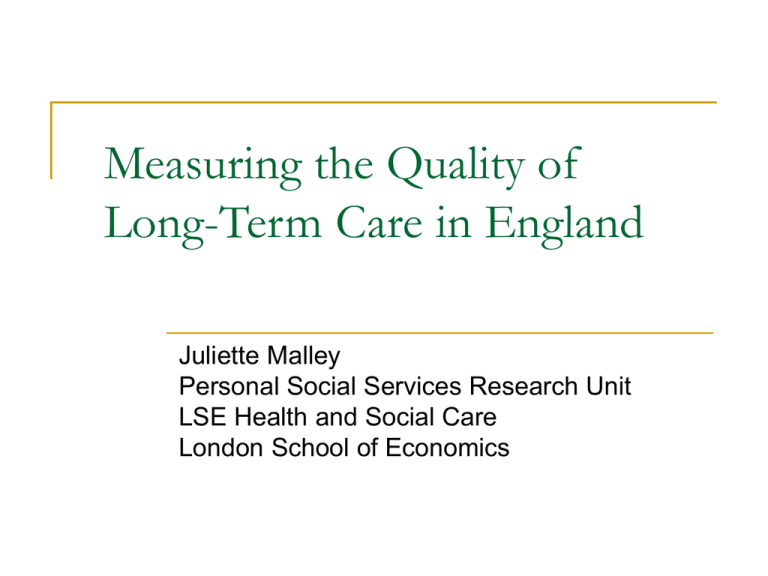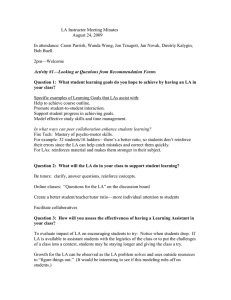Measuring the Quality of Long-Term Care in England
advertisement

Measuring the Quality of Long-Term Care in England Juliette Malley Personal Social Services Research Unit LSE Health and Social Care London School of Economics Structure Key players in England Main features of quality assurance programme Quality measures Evidence on quality Limitations of measures Key players – focus of inquiry NHS not focus LTC is social care not health care LAs responsible for social care Dual focus on Local Authorities (LAs) + care providers Quasi-market – LAs commissioners Private market – social care is means tested Key players – Measurement Policy-makers Regulator Department of Health (DH) Communities and Local Government department (CLG) Set policy, QA framework, objectives & what data should be collected Care Quality Commission (CQC) Drive quality improvement Others – limited role Academics LAs for contracting purposes Approach to quality assurance (QA) National system supported by legislation Comprehensive ‘Business approach’ Inspections integrated into performance assessment Measures support QA i.e. PIs… …& emerge from QA process i.e. ratings Quality measures What is the object of measurement? How is quality conceptualised? How are the measures specified and by whom? How are the measures used? What is the object of measurement? LAs Role as commissioners Role as market-shapers Care providers Provision by residential providers Provision by home care providers How is quality conceptualised? ‘Outcomes’ for service users Improved health & emotional well-being Improved quality of life Making a positive contribution Increased choice and control Freedom from discrimination or harassment Economic well-being Maintaining personal dignity and respect NOT clinical outcomes e.g. pressure ulcers Previous focus on ‘structure’ and ‘process’ How are the measures specified and by whom? (1) Performance indicators (PIs) For LAs only Quantitative measures From surveys and data systems Various types: activity, costs, process & structural quality No outcomes but new PIs under development E.g. % of items of equipment and adaptations delivered within 7 working days How are the measures specified and by whom? (2) Composite measures For LAs and providers Rating awarded on scale of one to four Judgement made by CQC inspectors Based on mix of qualitative and quantitative data Annual for LAs After key inspection for providers, frequency depends on judgement Inspections, management, self-assessment, PIs Aim to address partial picture presented by PIs How are the measures used? PIs Support planning process locally Accountability Used by CQC in performance assessment Targets, with financial reward Composite measures Determine relationship with regulator e.g. frequency of inspections, degree of intervention Public accountability Correct information asymmetries – efficient markets What is the quality of LAs? Quality of LAs measured by composite rating 100 90 80 Frequency of LAs 70 60 Zero One Two Three 50 40 30 20 10 0 2002 2003 2004 2005 2006 2007 2008 And for providers… Quality of providers measured by composite rating 70% Percentage of providers with quality rating 60% 50% 40% Zero One Two Three 30% 20% 10% 0% 2008 2009 Nursing home 2008 2009 Home care agency 2008 2009 Residential home And from the user survey data… Quality of LAs measured using data from user experience surveys Percentage of respondents responding above PI threshold 90.00 85.00 80.00 75.00 70.00 65.00 60.00 55.00 2000/01 2001/02 2002/03 Help quickly PI Satisfaction PI 2005/06 Suitable times 2008/09 Limitations of measures (1) Composite measures Sensitivity questions Reliability/accuracy questions Averaging across different domains Consistency of inspector judgements Sensitive to rules applied for scoring Policy changes means data & rules used changed over time Not updated annually for good/excellent providers – rely on stability and self-assessment If measures are not sensitive/reliable will/should they be used for commissioning? Limitations of measures (2) PIs Changes in definitions Policy changes – new PIs & old dropped Captures aspects of process to date, not outcomes Limitations of measures (3) Measures used to change behaviour Improvements could be result of pressure applied to improve e.g. PIs are targets – distribution condenses e.g. increased monitoring & intervention for poor performers – distribution condenses e.g. provider ratings for good/excellent not updated annually – tend towards improvement If measures do not have variability are they useful? Independent data would be valuable Conclusions Great start… National & comprehensive system for QA National quality measures Combine ‘soft’ & ‘hard’ data But some questions over accuracy & sensitivity… Some questions over whether these measures are useful for commissioning, particularly in long-run Independent assessment of validity & reliability of national measures would be valuable
